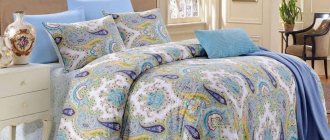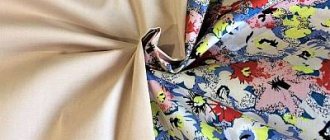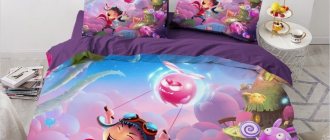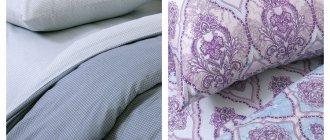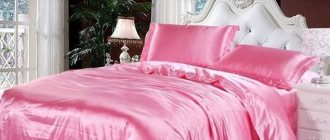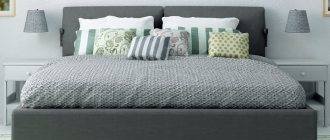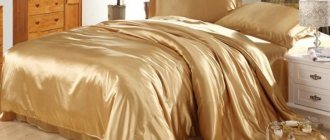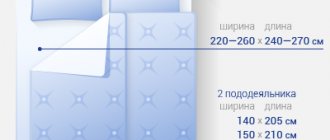Despite the abundance of fabrics with synthetic threads that have emerged as a result of new technologies in weaving, materials with natural fibers remain the best and most in demand. And one of the leaders is natural fabric - poplin, which deserves special attention.
A thin, dense thread is used for the warp and a thicker, coarse thread for the cross weft. The density of the warp is 1.5-2 times denser than in the cross weft. In this regard, the canvas has a texture with a light raised rib.
This reversible fabric is produced by a simple plain weave.
Origin of the fabric (History / Where it came to us from, what does the translation mean)
The first mention of poplin occurs in the 14th century. The technology for producing fabric was invented by French weavers specifically for clergy. The residence of Pope Clement V with his entire retinue at that time was in France in the city of Avignon. The name of the fabric was fixed from the French. Popeline, translated as “papal”. In Italian, a word with a similar sound is Papalino.
Initially, the fabric was woven from silk threads and it cost fabulous money. Later, silk thread was replaced with more affordable cotton thread.
Poplin manufacturing technology involves weaving threads of varying thicknesses.
In Russia, poplin appeared in the 18th century and was called “European calico.” Thin, soft natural material gained recognition in the market of that time.
Currently, poplin is produced almost all over the world. Weaving factories in Russia offer a wide selection of poplin.
Origin of fabric
Papalino means "papal" in Italian.
The fabric first appeared in the city of Avignon. They began to make clothes from it starting in the 14th century. The Pope chose poplin for his outfits and the clothes of his immediate circle. The name of the material is translated from Italian as “papal”. Modern poplin is produced in China and India.
Silk elite poplin made of natural silk with natural wool
What is made from poplin?
Natural, environmentally friendly material is universal. The advantage of poplin is a large selection of textures and colors. They sew from it:
- Bed linen sets. Soft, inexpensive cotton textiles are great for a comfortable night's rest.
Poplin bedding
- Home textiles: curtains, bedspreads, tablecloths, napkins, various accessories for interior decoration. The elegant, airy fabric drapes easily, hardly fades, and combines perfectly with other materials.
Poplin curtains
- Romantic dresses for summer holidays, shirts, suits. Poplin has good air exchange, as a result of which the body is not subject to the greenhouse effect and breathes easily. The clothing is suitable for everyday use. A poplin blouse will fit effectively on any female figure; the fabric holds its shape perfectly, emphasizing femininity. Please note that poplin in light colors is slightly see-through, unlike fabric in darker shades.
- Children's clothes, pajamas, underwear. Cozy, delicate textiles are pleasant to the skin, natural yarn is hypoallergenic.
- Bedding for cribs. Such pillowcases and sheets will not cause irritation to your baby's delicate skin.
Poplin bedding for cribs
- In needlework: sewing soft toys and dolls, patchwork, scrapbooking, applique. Poplin is durable, convenient to use in needlework, and easy to wash.
- Fashion designers use poplin to create their collections. An excellent option for everyday, business, basic wardrobe. A small weave of stretch threads into the product and the clothing will hold its shape well and fit perfectly. They enjoy sewing formal clothes - jackets, cardigans, elegant cocktail dresses.
Poplin shirts for men
Application area
The use of the material directly depends on its composition.
In the 19th century, one duchess used a poplin dress as a bathing suit. It was from poplin that robes for academicians were sewn. During the Second World War, soldiers' underwear was made of poplin fabric. What are they sewing from poplin today?
Natural cotton material is used for sewing bedding sets and children's clothing.
Poplin of mixed composition is used for underwear and home casual wear, elegant dresses and underwear. Poplin is also widely used in the manufacture of home textiles.
Poplin is popular among needlewomen - lovers of modern trends in patchwork, scrapbooking, as well as for sewing toys and making accessories.
You might be interested in this Composition and description of mako-satin: use in bedding, comparison with satin
Patchwork fabric
Poplin pros
The advantages of this material are as follows:
- Strength and wear resistance. Quality characteristics are maintained for a long time.
- Good air exchange and low thermal conductivity ensure comfortable use of textiles in clothing for leisure and active sports. Keeps warm well in cold weather, does not create a greenhouse effect for the body in hot weather, and cools pleasantly. Matter breathes.
- Absorbs moisture well and does not cause discomfort.
- Resistant to fading. Colors remain bright and rich even after prolonged exposure to sunlight.
- Easy to care for. Wash and iron well. Poplin practically does not wrinkle, thanks to its stable embossed weaving. Therefore, you can do without ironing altogether. If you have a steam generator, that's great. Having steamed the item once or twice, we end up with a perfectly flat surface.
- Inert. Not electrified.
Affordable price for poplin. Quite affordable prices, everyone can afford it
Poplin cons
Negative qualities appear when production technology is not followed: if low-quality starting material is taken, unacceptable artificial impurities in the fabric and the use of low-quality dyes. In these cases, the following disadvantages appear:
- Persistent smell of chemical dyes. After the first wash the item sheds a lot.
- Product deformation. The item quickly loses its shape and shrinks a lot after washing.
- The surface of the fabric gets dirty, and over time, pellets form. The thing becomes electrified.
Adding polyester to poplin makes the product cheaper and reduces its quality characteristics.
All these disadvantages can be avoided by purchasing fabric from trusted retail outlets and branded stores. Online stores selling poplin and products made from it also need to be carefully checked.
Care instructions
The fabric is unpretentious:
- washing is possible at temperatures up to 60 degrees, fabric can be washed well even at 40 degrees;
- soiled cotton poplin can be boiled and washed at 90 degrees;
- You can use regular washing powder, no special products are required;
- Machine spinning at maximum speed and machine drying are allowed;
- It is not necessary to iron poplin products; they take their shape on their own after washing.
Depending on the fabric composition, the product may require slightly different care conditions. All the necessary information is on the tag, read it carefully before washing for the first time and strictly follow the instructions. The service life of poplin items will increase significantly.
Bed linen – poplin, satin, calico – which is better to choose?
The best material for bedding is cotton. The most popular sleep sets are sets made of calico, satin and poplin. To make a choice, you need to carefully study all the pros and cons and conduct a comparative analysis of fabrics.
| Characteristics | Calico | Satin | Poplin |
| Appearance | smooth matte | silky | thin with a matte sheen, fine scars on the surface |
| Tactile sensations | new underwear is a bit harsh, but after a few washes it becomes softer | the most pleasant | smooth, soft, elastic |
| Density | lowest | the tallest | denser than calico and lighter than satin |
| Durability | strong and durable | most durable | slightly inferior to calico |
| Price | lowest | the tallest | average |
| Colors | ordinary | diversity | inferior to satin |
| Ironing | at high temperatures | easy to iron | does not need, does not wrinkle |
| Washing temperature | normal wash at 30-600 | withstands up to 950 | gentle wash at 30-400 |
| Washing cycles | up to 200 | up to 300 | up to 150 |
Having studied all the advantages and disadvantages of fabrics, you can choose the best bedding set for yourself. If luxury, quality are important to you and the price is not scary, then definitely choose satin underwear.
Poplin is a more budget option, but is almost as good in quality. Calico is an even more budget option, simpler, but quite worthy.
Differences between satin and poplin
Satin and poplin are made entirely from cotton, both are used for sewing bed linen. But it’s no coincidence that they have different names. This means that there are differences between fabrics. What is the main difference between satin and poplin?
The most important difference between poplin and satin is the weaving method. Satin fabric has a special quality - satin. After three rows, a weft thread is woven into the fourth. In addition, it is not smooth, but twisted. This is what gives satin its strength and shimmering silky shine.
Note! Satin is even called cotton silk. In addition, satin products are smooth to the touch, the front side is completely devoid of scars and other relief.
Poplin has a regular plain weave, the fibers are woven in a checkerboard pattern. Scars form on the surface of the fabric, which makes the fabric somewhat rough. But poplin has one undoubted advantage over satin. It is much stronger than satin, which also has high strength characteristics. But poplin is ahead of it in these indicators. This means that the products will withstand repeated washing, will last longer and will not lose their decent appearance; they will still look just as attractive. Due to simpler weaving, the process of making poplin is less expensive. And this has a positive effect on the cost of the material.
You may be interested in: What types of genuine leather exist, used in shoes and clothing?
However, the materials fully comply with GOST, which regulates the characteristics of fabrics for bed linen.
Differences in weaving fabrics
Poplin and percale - what's the difference?
Both of these fabrics are quite popular and in demand among consumers. After conducting a comparative analysis of poplin and percale bed linen, we draw our own conclusion and choose what is more preferable for us.
Both materials are good, each in their own way. The difference is in the appearance of the material, strength and price.
Percale is a high-strength cotton fabric. It is woven from untwisted threads using a special processing method called sizing. The warp thread is treated with a special adhesive called sizing.
Percale linen is stronger and more wear-resistant. Strength can also be confirmed by the fact that parachutes are sewn from percale
Percale fabric has a soft, velvety texture, a slight semi-matte sheen, and wrinkles easily. Poplin fabric is smoother and practically wrinkle-resistant.
Poplin bedding sets are more budget-friendly.
When choosing, you should take into account one more important factor: the dressing in percale can cause allergic reactions. Use this fabric with caution on children.
Comparison of poplin and satin in the table
Satin differs from poplin in price, weaving, smoothness, softness, and practicality. You can compare fabrics for a long time. For convenience, we suggest using a table with characteristics, pros and cons, and the price of bed linen:
| Poplin | Satin | |
| Weaving type | Linen. The weft threads are loose and thick, while the warp threads are thin and strong. | Satin. The ratio of warp threads to weft threads is 1 to 4. |
| Compound | 100% cotton, cotton with polyester, silk and wool | 100% cotton, polyester with cotton, 100% polyester |
| Density | 110-120 g/m² | 100-130 g/m² |
| Surface | slightly rough | smooth, silky |
| Shine | weak | Yes |
| Softness | +- | ++ |
| Ability to absorb moisture | ++ | +- |
| Air permeability | ++ | +- |
| Care | Wash at 40-60 degrees, spin 800 rpm. Does not require ironing | Wash at 40 degrees, extra rinse, minimal spin. Ironing is not required |
| Life time | 300-500 washes | 300-350 washes |
| Cost of a set of bed linen | 1700-2100 rub. | 2100-4500 rub. |
| Main advantage | Attractive appearance and practicality at an affordable price | Silky, great look |
| Main disadvantage | May have unnatural composition | Short service life at a relatively high price |
Varieties of poplin by composition
- Cotton. Classic look. They use cotton grown in Uzbekistan, India, Turkey, and Pakistan.
Cotton poplin
- Silk. Wool and silk fibers are used to make fabric. Expensive material for luxury bedding.
Silk poplin
- Mixed. Synthetic or viscose thread is added to the cotton thread. The fabric composition has different proportions of threads: cotton + viscose, cotton + synthetics, cotton + wool. The strength and wear resistance of the fabric increases, the price decreases. Types of mixed fabrics:
- polypoplin. High synthetic content. The fabric washes well, dries quickly, does not deform, but does not absorb moisture well, does not breathe and is rougher on the body.
- macopoplin. 80% cotton and 20% polyester. High density, durability and wear resistance while maintaining hygroscopicity and breathability.
- Stretch poplin. Threads of elastane and lycra are added to dress poplin.
- Stripe poplin. A pattern in the form of stripes across the entire width of the fabric. The coloring pigment is applied by printing onto the finished fabric.
Stripe poplin
Poplin fabric: composition and main characteristics
Pure cotton poplin is made from 100% natural fabric
Most manufacturers use natural cotton for production. Additionally, silk can be introduced to dilute the fabric. To increase the strength of the product, synthetic elements are sometimes added. Pure cotton fabrics are distinguished by their high cost and quality. They wear out more slowly. Poplin has some distinctive features.
- Density. Special weaving creates good density. The canvas does not lose its smoothness. While durable, it remains soft.
- Hygroscopicity. A distinctive feature is good moisture and air permeability. Relevant for clothing to a greater extent. Thanks to the breathable effect, the products are always comfortable and pleasant to be in.
- The product wrinkles badly. The scars are located transversely, and the structure of the fabric is embossed. These factors allow the product to keep its shape perfectly.
- Easy to care for. The fabric does not fade after washing and does not change size. You do not need to purchase any special detergents for care. Ironing is also easy, without using reduced modes.
- Availability. There are different price categories for products. The cost depends on the composition of the canvas and its quality. You can choose the right option for any wallet.
Striped two-tone ribbed poplin
Types of poplin by coloring
Depending on the type of fabric dyeing and the method of applying the pattern, poplin can be:
- Bleached. By treating with alkali and acid, the fiber becomes boiling white.
Bleached poplin
- Plain painted. The bleached fabric is dyed in the desired color on special drums for a long time (about 10 hours). The color is plain pastel tones. Coloring is carried out in several cycles for a more saturated and stable color.
Plain-dyed poplin
- Printed. Poplin jacquard. The design is applied to the finished fabric by machine airbrushing using mesh templates.
Dress poplin with printed pattern
- Multicolored. The design is made with threads of different colors. For this type, simple, original ornaments are chosen.
Multi-colored poplin
Pattern application using new technologies:
- Printed. The ornament is applied to the finished fabric. There are several paint application technologies.
- Vytravnoy. The pre-dyed fabric is etched in the right places according to the design diagram.
- Spare. Printing on fabric coated in the right places with a reserve mixture, which protects the fabric from staining. After drying, the reserve layer is removed.
Printed painting
Types of poplin depending on purpose
- Bed;
- Dress;
- Shirt;
- Believa;
- Children's;
- Curtain.
Children's poplin
Types of fabric depending on color and pattern
- Bleached poplin as a result of chemical treatment. It turns out completely white and durable. The material is devoid of ugly yellowish and gray shades. The procedure can be final for obtaining a white canvas or preliminary for subsequent dyeing.
- The plain-dyed material is first bleached and then painted in the desired color on special drums. It goes through several cycles of dyeing and washing over time, which ensures resistance to fading.
- The printed material has a pattern applied on special machines. The paint does not fade in the sun and is safe for health. Prints and patterns are applied to the canvas using airbrushing, using mesh templates and by machine.
- Multi-colored poplin as in the photo is obtained by using multi-colored threads for weaving. The threads are pre-dyed with a reagent dye in three steps. First, adsorption occurs with the absorption of particles. Then diffusion, when the pigment penetrates deep. The process is completed by fixing the dye.
- Printing is obtained by applying a realistic and clear pattern or ornament to the material. Several technologies are used.
- Direct, when the dye goes directly onto the base. Sometimes the paint is fixed on top with a film, which makes the fabric stiffer and reduces air permeability.
- Etched with a pattern applied to a pre-painted base. In the right places, the dye is simply etched.
- Reserve printing, in which individual areas are coated with a reserve mixture that protects against the ingress of dye. After painting and drying, the reserve composition is removed.
Poplin products: how to care? (Does the fabric need special care?)
The manufacturer indicates recommendations for caring for the product on the label. Special conditions may arise with certain fabric compositions. When adding silk or viscose thread, the quality characteristics of the textile change. There is a need for more careful care of the product. Therefore, it is important to familiarize yourself with the recommendations and follow them.
Poplin fabric is unpretentious, but with careful care it retains its quality characteristics for a longer time.
Wash
Before washing, sort your laundry by color and texture. Poplin bed linen should be washed separately from other types (towels, clothes).
- Turn the product inside out. Fill the drum of the automatic machine to 60% of the total drum volume. There is no need to fill it to capacity; the laundry should rotate freely when washing.
There is no need to stuff it to capacity; the laundry should rotate freely when washed.
- Wash at a temperature no higher than 400. Machine washing requires turning on the gentle cycle. Pure cotton poplin can easily withstand even boiling, but it is better to use it infrequently.
- It is strictly not recommended to use bleach for colored products. Whiteness is especially dangerous for fabric.
When rinsing, add conditioner to soften the fibers and preserve color.
- The spin should also not be set to maximum speed so that the product does not become deformed.
- Dry flat and out of direct sunlight. The sun dries, making the laundry harder.
Ironing
There are also no special instructions for the ironing process. But you should follow the general rules:
Iron clothes when slightly damp
- Poplin is practically wrinkle-resistant, so you can do without ironing if the linen is loose enough.
- The optimal heating temperature for the soleplate of the iron is 110-120 degrees.
How to care for fabric for long life
Poplin is easy to care for. But a lot depends on its composition. For pure cotton options it is recommended:
- Wash at approximately 60°C. Contaminated items can be washed at +95°C.
- Spin at medium drum speed.
- Ironing is usually not required. The main thing is to straighten out wet things. If necessary, iron using a not very hot iron, turning on the “cotton” mode.
Even more caution will be required if it contains polyester. Then the maximum temperature threshold cannot exceed +40°C. For silk, the temperature should not be higher than 30°C.
Advice. To wash poplin, you can use regular powders. Silk items should be washed with liquid detergents with a special mark. Use bleaches with caution. To preserve the original color, wash items turning inside out. When drying, avoid direct sunlight. Organize storage in dry, ventilated cabinets or chests of drawers.
How to choose
The right choice of bed linen is the key to a good mood and comfortable rest for many years.
- You should only buy from a trusted seller. In a branded store from the manufacturer or from an intermediary in whom you are confident. An on-site consultant will always give qualified advice, introduce you to the store’s assortment, and help you with your choice.
- The presence of polyester in textiles makes it stronger, but reduces the cost of the product. Over time, pellets form on the surface.
- When purchasing, pay attention to the quality of the seams. The seam should be smooth, without protruding threads.
- The color and pattern on high-quality fabric is always crisp and clear. The smell of chemicals indicates the use of low-quality dye.
- Natural textiles do not wrinkle. When crumpled, it quickly takes its original shape, leaving no creases.
Bed linen sizes
Bed linen sets have certain sizes corresponding to the blankets and pillows produced by our production.
- 1.5-bed set: duvet cover 140 (170)*200 (220) cm, sheet 140 (180)*180 (260), one or two pillowcases.
- 2-bedroom: duvet cover 180 (200) * 200 (220) cm, sheet 170 (200) * 200 (260), two or four pillowcases.
- Euro standard: duvet cover 200 (220)*210 (220), sheet 200 (240)*220 (260), two or four pillowcases.
- Family (duet): 2 duvet covers 140 (150)*200(220), sheet 200 (240)*220 (260) cm, two or four pillowcases.
- Children's: duvet cover 110 (120) * 140 (150) cm, sheet 60 (110) * 120 (150) cm, pillowcase 40 * 60 cm
Note:
- The dimensions of the pillowcases are 50*70 and 70*70 cm. The size of the pillowcases and their number in the set must be indicated on the packaging.
- Duvet covers come in regular or zippered versions.
- Sheets can be a regular rectangular shape or with an elastic band. Manufacturers most often indicate the dimensions of fitted sheets according to the dimensions of the mattress + the height of the mattress.
- The choice of bed linen is huge: for every taste, color and budget.
Housewives make the right choice, giving preference to poplin bed linen. High-quality fabrics will decorate the bedroom and guarantee a healthy sleep.
Reviews
promokashka. Anyone who has already tried poplin underwear will be looking for something similar for something new. The big plus is that it is natural, 100% cotton. It is hypoallergenic, and this is important for many now. The fabric is very pleasant to the touch, smooth and soft. In winter, when the apartment is not hot, the bed when you lie down does not seem so cold, perhaps because of the same softness, I think. It does not wrinkle much, i.e. Everything wrinkles, but the poplin retains its decent appearance and it’s not very noticeable. It washes perfectly, the design does not lose its brightness for a very long time. Ironing is easy, although I don’t do it often myself, the main thing is to dry it evenly and fold it right away.
Lenore. I once bought poplin bed linen on the advice of the woman who ordered it for me; before that they only bought calico. To be honest, I don’t understand fabrics, but here, as they say, the results are obvious. The fabric is very pleasant to the body, the color has not changed at all after washing, the linen is stronger than calico and at the same time softer. By the way, we took a family set for 1300, although before that we paid one and a half for calico, I was very pleased, now I want to take a couple more, because we have a lover of tearing up sheets(
hoht. When I bought poplin bed linen, I was attracted by the fact that it was 100% cotton. I bought it as a gift and liked the large selection of colors. I also took a set for myself. Everyone is happy with this underwear. Only one minus is that you need to wash at 30 degrees. This means that you need to wash it separately and do not forget to switch the temperature.
Which is better to choose?
Satin and poplin are equally worthy of attention. They are among the TOP 5 best fabrics for bed linen. Further choice depends on personal preferences, body characteristics, income and taste:
- If you want a rich, silky bedding set, it is better to choose satin.
- If you need nice and soft bed linen, and showiness is not too important, you should give preference to poplin. This will also result in some good savings.
- Both options are good for a gift, but poplin will appeal more to older people, and satin to younger people.
- People who sweat a lot will find it more comfortable to sleep on poplin.
- For people with hypersensitive and delicate skin, satin bedding is more suitable.
- For children, it is better to choose 100% cotton poplin.

